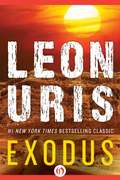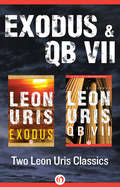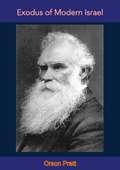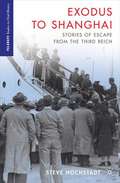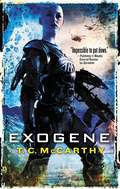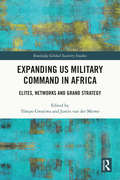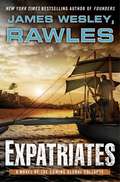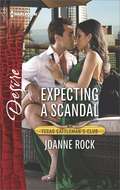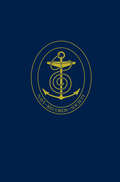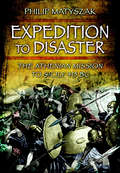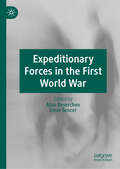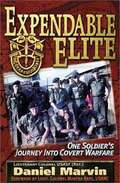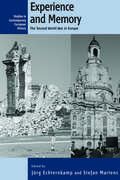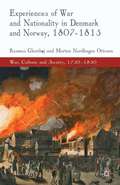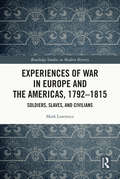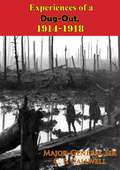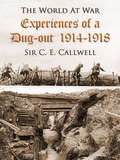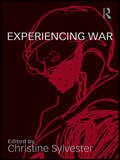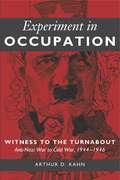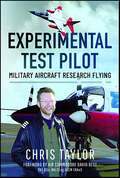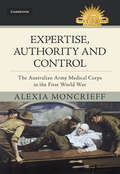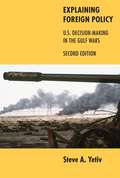- Table View
- List View
Exodus
by Leon UrisThe epic saga of Israel's earliest days and the people who fought to make it their home The Exodus was just one ship among many that carried survivors of the Holocaust to Palestine to establish a new nation. But the path that Jewish immigrants took to enter British-controlled Palestine was a difficult one, fraught with danger and political intrigue. The boat was intercepted by British forces and the refugees were placed in concentration camps. Uris's blockbuster novel traces the lives of the men and women who brave British naval blockades to help Israel come into being, from Ari Ben Canaan, who works tirelessly to smuggle in settlers, to Kitty Fremont, an American nurse drawn into a vast, tragic history. Weaving together fact and fiction, history and dramatic storylines, Exodus stands today as one of the most influential narratives of the founding of the State of Israel. This ebook features an illustrated biography of Leon Uris including rare photos from the author's estate.
Exodus & QB VII: Two Leon Uris Classics
by Leon UrisA special two-in-one edition by a master of storytelling, featuring Exodus, the epic saga of Israel's earliest days, and QB VII, the story of a writer accused of committing atrocities during World War II. The Exodus was just one ship among many that carried survivors of the Holocaust to Palestine to establish a new nation. But the path that Jewish immigrants took to enter British-controlled Palestine was a difficult one, fraught with danger and political intrigue. The boat was intercepted by British forces and the refugees were placed in concentration camps. Uris's blockbuster novel traces the lives of the men and women who brave British naval blockades to help Israel come into being, from Ari Ben Canaan, who works tirelessly to smuggle in settlers, to Kitty Fremont, an American nurse drawn into a vast, tragic history. Weaving together fact and fiction, history and dramatic storylines, Exodus stands today as one of the most influential narratives of the founding of the State of Israel. In QB VII, for Abe Cady, settlement is not an option when the facts of the Holocaust are on trial. A journalist and screenwriter, Cady produced the definitive account of the Holocaust just after World War II. But Polish doctor Adam Kelno, who was pressed into service in a notorious concentration camp, sues Cady for his book's claim that the doctor conducted terrible experiments on camp inmates. The libel trial that follows tears open old wounds, disrupts lives, and becomes a battle for justice on behalf of tens of thousands of lost and damaged souls. QB VII is a gripping drama, largely based on author Uris's own protracted libel defense against a former concentration camp surgeon named in his novel Exodus. It was made into the first miniseries in television history.
Exodus and QB VII
by Leon UrisA special two-in-one edition by a master of storytelling, featuring Exodus, the epic saga of Israel's earliest days,and QB VII, the story of a writer accused of committing atrocities during World War IIThe Exodus was just one ship among many that carried survivors of the Holocaust to Palestine to establish a new nation. But the path that Jewish immigrants took to enter British-controlled Palestine was a difficult one, fraught with danger and political intrigue. The boat was intercepted by British forces and the refugees were placed in concentration camps.Uris's blockbuster novel traces the lives of the men and women who brave British naval blockades to help Israel come into being, from Ari Ben Canaan, who works tirelessly to smuggle in settlers, to Kitty Fremont, an American nurse drawn into a vast, tragic history. Weaving together fact and fiction, history and dramatic storylines, Exodus stands today as one of the most influential narratives of the founding of the State of Israel.In QB VII, for Abe Cady, settlement is not an option when the facts of the Holocaust are on trial. A journalist and screenwriter, Cady produced the definitive account of the Holocaust just after World War II. But Polish doctor Adam Kelno, who was pressed into service in a notorious concentration camp, sues Cady for his book's claim that the doctor conducted terrible experiments on camp inmates. The libel trial that follows tears open old wounds, disrupts lives, and becomes a battle for justice on behalf of tens of thousands of lost and damaged souls.QB VII is a gripping drama, largely based on author Uris's own protracted libel defense against a former concentration camp surgeon named in his novel Exodus. It was made into the first miniseries in television history.
Exodus of Modern Israel: Being The Daily Diary Of Orson Pratt
by Orson PrattThis book, which was first published in 1947, is the daily diary of Orson Pratt on the exodus of the Latter-Day Saints from Nauvoo, Illinois to the Rocky Mountains in Colorado. It also contains detailed information on plans instituted by the Prophet Joseph Smith for this Exodus, as related by Anson Call, Wilford Woodruff, Brigham Young, Historian Edward W. Tullidge, Samuel W. Richards, Helen Mar Whitney, and by Joseph the Prophet himself.
Exodus to Shanghai
by Steve HochstadtOf the 400,000 German-speaking Jews that escaped the Third Reich, about 16,000 ended up in Shanghai, China. This groundbreaking volume gathers 20 years of interviews with over 100 former Shanghai refugees. It offers a moving collective portrait of courage, culture shock, persistence, and enduring hope in the face of unimaginable hardships.
Exogene (The Subterrene War #2)
by T. C. MccarthyExogene (n.): factor or agent (as a disease-producing organism) from outside the organism or system. Also: classified Russian program to merge proto-humanoids with powered armor systems (slang).Catherine is a soldier. Fast, strong, lethal, she is the ultimate in military technology. She's a monster in the body of an eighteen year old girl. Bred by scientists, grown in vats, indoctrinated by the government, she and her sisters will win this war, no matter the cost.And the costs are high. Their life span is short; as they age they become unstable and they undergo a process called the spoiling. On their eighteenth birthday they are discharged. Lined up and shot like cattle.But the truth is, Catherine and her sisters may not be strictly human, but they're not animals. They can twist their genomes and indoctrinate them to follow the principles of Faith and Death, but they can't shut off the part of them that wants more than war. Catherine may have only known death, but she dreams of life and she will get it at any cost.
Expanding US Military Command in Africa: Elites, Networks and Grand Strategy (Routledge Global Security Studies)
by Justin van der Merwe Tshepo GwatiwaThis book discusses the systematic expansion of the United States Africa Command (AFRICOM) across the continent of Africa. This book posits that AFRICOM expansion in Africa is part of a broader system of accumulation based on a government-business-media (GBM) complex. Applying the concept at both structural and descriptive levels, the GBM complex is a function of the synergy between the state’s quest for power, businesses’ need for expansion, and the informational and hegemonic functions of media actors. The United States’ GBM complex in Africa is supported—and in some locations spearheaded—by its military, with dispossessing effects on local actors. Drawing from African case studies, analytical accounts and empirical case studies, this book explores AFRICOM’s role within this broader strategy. The volume maps both the methods and the scope of this expansion, as well as local resistance to this process, and comprises perspectives from the five regions of Africa, key sub-regional organizations and voices from Africa’s regional hegemons. This book will be of much interest to students of security studies, strategic studies, African politics and International Relations.
Expatriates: A Novel of the Coming Global Collapse
by James Wesley RawlesIn the latest survivalist thriller from founder of survivalblog. com and New York Times bestselling author James Wesley, Rawles, two expat families struggle for their very survival in the midst of a global economic collapse. When the United States suffers a major socioeconomic collapse, a power vacuum sweeps the globe. A newly radicalized Islamic government rises to power in Indonesia, invades the Philippines, East Timor, Papua New Guinea, and finally northern Australia. No longer protected by American military interests, Australia must repel an invasion alone. In the thick of these political maneuvers, an American family of missionaries living in the Philippines and a Texan petroleum engineer in Australia must face the fear of being strangers in a world in flux. Are their relatives back home healthy and safe? Will they ever see them again? In its depiction of the authentic survivalist skills and techniques needed to survive a global socioeconomic meltdown, Expatriates is as informative as it is suspense-filled.
Expecting a Lone Star Heir (Texas Promises #1)
by Sara OrwigA Texas affair leads to a little surprise! Only from USA TODAY bestselling author Sara Orwig.Former army ranger Mike Moretti is finding it hard to remember that Vivian Warner is forbidden. She’s his late buddy’s widow and his new boss. Mike hired on at the Warner ranch to help Vivian, not to seduce her. But playing the role of pretend suitor leads to irresistible temptation…and an unexpected pregnancy. This cowboy’s code of honor demands he do the right thing, but Vivian won’t say, “I do,” for anything less than love. Expecting a Lone Star Heir is part of the Texas Promises trilogy.
Expecting a Scandal: Expecting A Scandal (texas Cattleman's Club: The Impostor, Book 4) / His Best Friend's Sister (first Family Of Rodeo, Book 1) (Texas Cattleman's Club: The Impostor Ser. #4)
by Joanne RockFive months pregnant and on her own. Even so, she can’t resist this rugged rancher…Solely responsible for her unborn child, Abigail Stewart is desperate for the art commission at Royal Memorial Hospital. Winning over the sexy Texan on the board seems impossible, but Vaughn surprises her with his response. And his attention. And a sizzling connection that defies all logic. But even if he can accept her baby, will Vaughn’s dark past tear them apart?
Expedition of Sir John Norris and Sir Francis Drake to Spain and Portugal, 1589
by R.B. WernhamActions against the Spanish Armada and campaigns in the Netherlands left the Queen’s coffers empty. For this reason proposals to capture the Spanish treasure fleet were given royal support. The treasure fleet homeward bound from the Americas would be intercepted in the Azores. A diversion at Santander to damage the Spanish fleet would prevent protection of the treasure fleet and, more importantly, prevent further actions against England or Ireland. However, the project was diverted further with backers wanting to re-instate Don Antonio as King of Portugal, with ideas of gaining lucrative Portuguese trade rights.At sea a further diversion was taken, with news of shipping at Corunna and the prospect of capturing merchantmen. ‘Profit was already challenging strategy’. This diversion gave their enemies more time to prepare. The failure at Lisbon was partly from a lack of co-ordination between the navy and army but also from the lack of promised support from Don Antonio’s supporters.The decision to sail for the Azores to intercept the Spanish treasure fleet was at last made only for Drake to be driven back to England by a storm. Short of supplies and with sick crews the ships were in no condition to continue with the Queen’s demands so there was no great treasure and the Spanish fleet was still in being. The sale of prizes and their contents failed to cover the cost of the expedition, and so the expedition was considered a financial and strategic failure.
Expedition to Disaster: The Athenian Mission to Sicily 415 BC
by Philip MatyszakThis thrillingly vivid history recounts a pivotal battle of the Peloponnesian War, bringing the drama and personalities of the Sicilian Expedition to life. The Athenian expedition to conquer Sicily was one of the most significant military events of the classical period. At the time, Athens was locked in a decades-long struggle with Sparta for mastery of the Greek world. The expedition to Sicily was intended to win Athens the extra money and resources needed to crush the Spartans. With the aid of new archaeological discoveries, Expedition to Disaster reconstructs the mission, and the ensuing siege, in greater detail than ever before. The cast of characters includes Alcibiades, the flamboyant, charismatic young aristocrat; Nicias, the ageing, reluctant commander of the ill-fated expedition, and Gylippus, the grim Spartan general sent to command the defense of Syracuse. It was he who turned the tables on the Athenian invaders. They were surrounded, besieged, and forced to ask for mercy from a man who had none. Philip Matyszak's combination of thorough research and gripping narrative presents an episode of ancient history packed with colorful characters and dramatic tension.
Expeditionary Forces in the First World War
by Emre Sencer Alan BeyerchenWhen war engulfed Europe in 1914, the conflict quickly took on global dimensions. Although fighting erupted in Africa and Asia, the Great War primarily pulled troops from around the world into Europe and the Ottoman Empire. Amid the fighting were large numbers of expeditionary forces—and yet they have remained largely unstudied as a collective phenomenon, along with the term “expeditionary force” itself. This collection examines the expeditionary experience through a wide range of case studies. They cover major themes such as the recruitment, transport, and supply of far-flung troops; the cultural and linguistic dissonance, as well as gender relations, navigated by soldiers in foreign lands; the political challenge of providing a rationale to justify their dislocation and sacrifice; and the role of memory and memorialization. Together, these essays open up new avenues for understanding the experiences of soldiers who fought the First World War far from home.
Expendable Elite: One Soldier's Journey into Covert Warfare
by Daniel MarvinAs a Green Beret, Lt. Col. Marvin was in a unique position to know what was going on during the Vietnam War. He wants the truth to be told, and has documentation to back up his statements.
Experience And Memory
by Stefan Martens Jorg EchternkampModern military history, inspired by social and cultural historical approaches, increasingly puts the national histories of the Second World War to the test. New questions and methods are focusing on aspects of war and violence that have long been neglected. What shaped people's experiences and memories? What differences and what similarities existed in Eastern and Western Europe? How did the political framework influence the individual and the collective interpretations of the war? Finally, what are the benefits of Europeanizing the history of the Second World War? Experts from Belgium, Germany, France, Great Britain, Italy, Luxembourg, Poland, and Russia discuss these and other questions in this comprehensive volume.
Experiences of War and Nationality in Denmark and Norway, 1807–1815
by Rasmus Glenthøj Morten Nordhagen OttosenThis book explores the impact of the Napoleonic wars on Danish-Norwegian society and accounts for war experiences and the transformation of identities among the popular classes and educated élites alike.
Experiences of War in Europe and the Americas, 1792–1815: Soldiers, Slaves, and Civilians (Routledge Studies in Modern History)
by Mark LawrenceThis work seeks to offer a new way of viewing the French Wars of 1792–1815. Most studies of this period offer international, political, and military analyses using the French Revolution and Napoleon as the prime mover. But this book focuses on military and civilian responses to French Revolutionary and Napoleonic wars, throughout the rest of Europe and the Americas. It shows how the unprecedented mobilization of this era forged a generation of soldiers and civilians sharing a common experience of suffering, bequeathing the West with a new veteran sensibility. Using a range of sources, especially memoirs, this book reveals the adventure and suffering confronting ordinary soldiers campaigning in Europe and the Americas, and the burdens imposed on civilians enduring rising and falling empires across the West. It also reveals how the wars liberated slaves, serfs, and common people through revolutions and insurgencies.
Experiences of a Dug-Out, 1914-1918 [Illustrated Edition]
by Major-General Sir C. E. CallwellIncludes the First World War Illustrations Pack - 73 battle plans and diagrams and 198 photosMajor-General Sir Charles Edward Callwell KCB was an Anglo-Irish officer of the British Army, who served in the artillery, as an intelligence officer, and as a staff officer and commander during the Second Boer War. As a noted strategist and well known in military circles, he was recalled [aka 'dug-out'] to the colours during the First World War, as part of the rapid expansion of the British Army from a small regular army to the mass volunteer army. He served as Director of Operations & Intelligence during the Gallipoli campaign and also on military missions to Russia and in staff posts in the Ministry of Munitions. In this memoir he recounts his experiences as a witness to the many successes, a few of the disasters and the unstinting effort of the high command of the British War effort during the First World War.
Experiences of a Dug-out, 1914-1918: 1914-1918 (classic Reprint) (The World At War)
by C. E. CallwellThe strategist Maj. Gen. Sir Charles Edward Callwell was recalled ['dugout'] from retirement in 1914 to serve as Director of Military Operations. He was removed from this post in January 1916 for perceived failings in the direction of the Dardanelles Campaign, and later served on military missions to Russia and in the Ministry of Munitions.
Experiencing 11 November 2018: Commemoration and the First World War Centenary
by Sumartojo ShantiIn a unique collection of international and interdisciplinary research, this book focuses on commemorative events around the world on the same day: 11 November 2018, the centenary of Armistice Day, the end of the First World War. It argues that we need to move beyond discourse, narrative and how historical events are represented to fully understand what commemoration does, socially, politically and culturally. Adopting an experiential reframing treats sensory, affective and emotional feelings as fundamental to how we collectively understand shared histories, and through them, shared identities. The volume features 15 case studies from ten countries, covering a variety of settings and national contexts specific to the First World War. Together the chapters demonstrate that a new conceptualisation of commemoration is needed: one that attends to how it feels.
Experiencing War (War, Politics and Experience)
by Christine SylvesterThis edited collection explores aspects of contemporary war that affect average people –physically, emotionally, and ethically through activities ranging from combat to television viewing. The aim of this work is to supplement the usual emphasis on strategic and national issues of war in the interest of theorizing aspects of war from the point of view of individual experience, be the individual a combatant, a casualty, a supporter, opponent, recorder, veteran, distant viewer, an international lawyer, an ethicist or other intellectual. This volume presents essays that push the boundaries of war studies and war thinking, without promoting one kind of theory or methodology for studying war as experiential politics, but with an eye to exploring the possibilities and encouraging others to take up the new agenda. It includes new and challenging thinking on humanitarianism and war, new wars in the Third World, gender and war thinking, and the sense of the body within war that inspires recent UN resolutions. It also gives examples that can change our understanding of who is located where doing what with respect to war –women warriors in Sierra Leone, war survivors living with their memories, and even an artist drawing something seemingly intangible about war –the arms trade. The unique aspect of this book is its purposive pulling together of foci and theoretical and methodological perspectives from a number of disciplines on a variety of contemporary wars. Arguably, war is an activity that engages the attention, the politics, and the lives of many people. To theorize it with those lives and perspectives in mind, recognizing the political contexts of war, is long overdue. This inter-disciplinary book will be of much interest to students of war studies, critical security studies, gender studies, sociology and IR in general.
Experiment in Occupation: Witness to the Turnabout: Anti-Nazi War to Cold War, 1944–1946
by Arthur D. KahnAs a participant in many of the events he writes about in Experiment in Occupation, Arthur Kahn offers a richly detailed account of the process by which the fight against Nazism came to be transformed into the Cold War. His story reveals how those in the Military Government of Germany who were dedicated to carrying out the war aims promulgated by Roosevelt and Eisenhower for a thorough democratization of Germany were ultimately defeated in their confrontation with powerful elements in the Military Government and in Washington who were more intent upon launching a preemptive war against the Soviet Union than upon the eradication of Nazism and German militarism. A twenty-three-year-old OSS operative, Arthur Kahn was assigned after D-Day to a psychological warfare unit, where at first he supervised prisoner-of-war interrogations and then served as an editor of intelligence. Instructed to respond to requests from Supreme Headquarters, he drafted proposals for psychological warfare approaches to critical situations at the front only to discover that a SHAEF directive banned calls to the Germans to revolt. Subsequently Kahn served in liaison with the Soviets and during the Battle of the Bulge at Montgomery's British headquarters. For several months before and after VE Day he traveled through the American Zone as an intelligence investigator and wrote a report that led to the dismissal of General George S. Patton as Military Governor of Bavaria. Appointed Chief Editor of Intelligence of the Information Control Division, he produced the most influential intelligence weekly in the American Zone. Kahn's portrayal of events in postwar Germany provides warnings for current and future American experiments in foreign occupation.
Experimental Test Pilot: Military Aircraft Research Flying
by Chris TaylorChris Taylor has had a very successful career as a Royal Navy officer, helicopter pilot, test pilot, instructor and as an internationally acclaimed civil certification test pilot. His first book, Test Pilot, concentrates on anecdotes and incidents from the most recent phase of his career. This book is the prequel and is his account of his ten years’ service as an experimental test pilot, from 1994 until 2004, at MoD Boscombe Down, the UK’s tri-Service home of military aircraft testing and evaluation. In this book, Chris explains what led to his passion to be a test pilot and how, with tenacity, he plays the cards he was dealt as well as he could. The story captures the difficulties and challenges associated with being selected for the single annual place at the Empire Test Pilots’ School (ETPS) and the dedication required to then complete the very demanding twelve-month course. Chris was one of only three helicopter experimental test pilots posted to the Experimental Flying Squadron (EFS). It was there that he worked with scientists from the defense Research Agency (DRA) at Bedford and Farnborough on a number of cutting-edge technologies, specializing in ship/helicopter interface testing. In addition to flying the Westland Wessex, Lynx and Sea King, Chris was able to act as an evaluation pilot in the Hunter, Jaguar, Andover, Hawker Siddeley HS748, and the Comet. During his time as an active test pilot, EFS was merged into three platform squadrons which gave Chris the chance to play a full part in conventional ‘release to service’ activities in a wide variety of rotorcraft. Asked to take on the role of a flight test instructor (FTI), Chris served at ETPS where he made sweeping changes to the syllabus, acquired a new helicopter type and had to deal with a number of students who could not cope with the rigors of the course. In his first year he suffered a ‘flame out’ in a Hawk jet, an engine failure during his first flight in the twin-engine Basset and crashed the school’s Westland Scout helicopter– all of which are fully discussed. Following four successful years teaching helicopter flight test, Chris was recruited to manage the ETPS short course portfolio. This required the design, sale and delivery of numerous flight test courses, while also introducing innovative teaching methods and the use of civil registered aircraft. In this new, exciting and rewarding role Chris taught both fixed wing and rotary wing students and the book explains the difficulties of learning the additional skills and flight test techniques required of a fixed wing test pilot. This autobiography explores the military flight test career of an individual who is arguably one of the best qualified and most experienced test pilots working today anywhere in the world.
Expertise, Authority and Control: The Australian Army Medical Corps in the First World War (Australian Army History Series)
by Alexia MoncrieffExpertise, Authority and Control charts the development of Australian military medicine in the First World War in the first major study of the Australian Army Medical Corp in over seventy years. It examines the provision of medical care to Australian soldiers during the Dardanelles campaign and explores the imperial and medical-military hierarchies that were blended and challenged during the campaign. By the end of 1918, the AAMC was a radically different organisation. Using army orders, unit war diaries and memoranda written to disseminate information within the Australian Imperial Forces (AIF) and between British and Australian soldiers, it maps the provision of medical care through casualty clearance and evacuation, rehabilitation, and the prevention and treatment of venereal disease. In doing so, she reassesses Australian military medicine and maps the transition to an infrastructure for the AIF in the field, especially in response to conflicts with traditional imperial, military and medical hierarchies.
Explaining Foreign Policy: U.S. Decision-Making in the Gulf Wars
by Steve A. YetivSteve A. Yetiv has developed an interdisciplinary, integrated approach to studying foreign policy decisions, which he applies here to understand better how and why the United States went to war in the Persian Gulf in 1991 and 2003. Yetiv's innovative method employs the rational actor, cognitive, domestic politics, groupthink, and bureaucratic politics models to explain the foreign policy behavior of governments. Drawing on the widest set of primary sources to date-including a trove of recently declassified documents-and on interviews with key actors, he applies these models to illuminate the decision-making process in the two Gulf Wars and to develop theoretical notions about foreign policy. What Yetiv discovers, in addition to empirical evidence about the Persian Gulf and Iraq wars, is that no one approach provides the best explanation, but when all five are used, a fuller and more complete understanding emerges. Thoroughly updated with a new preface and a chapter on the 2003 Iraq War, Explaining Foreign Policy, already widely used in courses, will continue to be of interest to students and scholars of foreign policy, international relations, and related fields.
